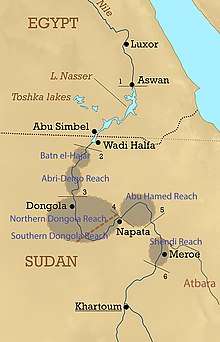Batn-El-Hajar
Batn-El-Hajar or Belly of Stones is a reach of approximately 160 km in length stretching from the Dal Cataract of the Nile downriver to the now under Lake Nubia submerged Second Cataract in present-day Sudan.[1]

History
Batn-El-Hajar is a barren and granite-rich landscape limiting arable soil and, thus, sparsely inhabited. It was the traditional border between Upper Nubia and Lower Nubia. In this area are a number of important A-Group[2] and Meroitics[3] archeological sites.[4]
gollark: https://pastebin.com/RM13UGFaIt runs in ComputerCraft.
gollark: Many hate me for it.
gollark: I did.
gollark: Is a potato.
gollark: <@!330678593904443393> Memory mapped IO.
References
- Geography of Nubia.
- Kathryn A. Bard (ed.); Encyclopedia of the Archaeology of Ancient Egypt; Routledge 1999; pp.83-84.
- William Y. Adams; Dynasties and Empires. The Southward Course of Empire. Meroitic Civilization of the Steppelands; in: Nubia: corridor to Africa; Princeton University Press; 1977.
- D. N. Edwards and A. J. Mills; 'Pharaonic' Sites in the Batn el-Hajar - the 'Archaeological Survey of Sudanese Nubia' Revisited; in: Sudan & Nubia, No 17, published by The Sudan Archaeological Research Society; 2013.
This article is issued from Wikipedia. The text is licensed under Creative Commons - Attribution - Sharealike. Additional terms may apply for the media files.